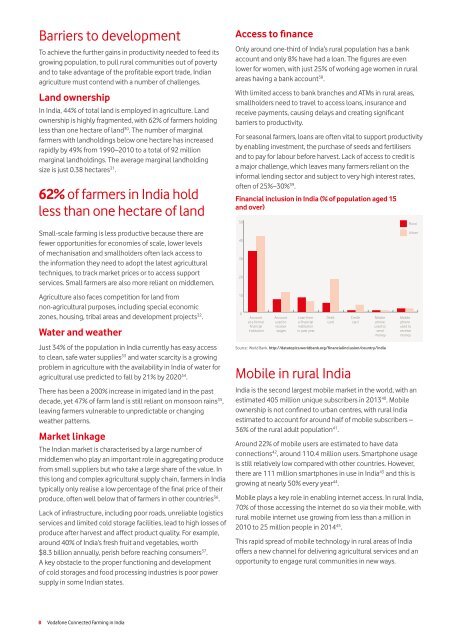Connected-Farmers
Connected-Farmers
Connected-Farmers
You also want an ePaper? Increase the reach of your titles
YUMPU automatically turns print PDFs into web optimized ePapers that Google loves.
Barriers to development<br />
To achieve the further gains in productivity needed to feed its<br />
growing population, to pull rural communities out of poverty<br />
and to take advantage of the profitable export trade, Indian<br />
agriculture must contend with a number of challenges.<br />
Land ownership<br />
In India, 44% of total land is employed in agriculture. Land<br />
ownership is highly fragmented, with 62% of farmers holding<br />
less than one hectare of land 30 . The number of marginal<br />
farmers with landholdings below one hectare has increased<br />
rapidly by 49% from 1990–2010 to a total of 92 million<br />
marginal landholdings. The average marginal landholding<br />
size is just 0.38 hectares 31 .<br />
62% of farmers in India hold<br />
less than one hectare of land<br />
Small-scale farming is less productive because there are<br />
fewer opportunities for economies of scale, lower levels<br />
of mechanisation and smallholders often lack access to<br />
the information they need to adopt the latest agricultural<br />
techniques, to track market prices or to access support<br />
services. Small farmers are also more reliant on middlemen.<br />
Agriculture also faces competition for land from<br />
non-agricultural purposes, including special economic<br />
zones, housing, tribal areas and development projects 32 .<br />
Water and weather<br />
Just 34% of the population in India currently has easy access<br />
to clean, safe water supplies 33 and water scarcity is a growing<br />
problem in agriculture with the availability in India of water for<br />
agricultural use predicted to fall by 21% by 2020 34 .<br />
There has been a 200% increase in irrigated land in the past<br />
decade, yet 47% of farm land is still reliant on monsoon rains 35 ,<br />
leaving farmers vulnerable to unpredictable or changing<br />
weather patterns.<br />
Market linkage<br />
The Indian market is characterised by a large number of<br />
middlemen who play an important role in aggregating produce<br />
from small suppliers but who take a large share of the value. In<br />
this long and complex agricultural supply chain, farmers in India<br />
typically only realise a low percentage of the final price of their<br />
produce, often well below that of farmers in other countries 36 .<br />
Lack of infrastructure, including poor roads, unreliable logistics<br />
services and limited cold storage facilities, lead to high losses of<br />
produce after harvest and affect product quality. For example,<br />
around 40% of India’s fresh fruit and vegetables, worth<br />
$8.3 billion annually, perish before reaching consumers 37 .<br />
A key obstacle to the proper functioning and development<br />
of cold storages and food processing industries is poor power<br />
supply in some Indian states.<br />
Access to finance<br />
Only around one-third of India’s rural population has a bank<br />
account and only 8% have had a loan. The figures are even<br />
lower for women, with just 25% of working age women in rural<br />
areas having a bank account 38 .<br />
With limited access to bank branches and ATMs in rural areas,<br />
smallholders need to travel to access loans, insurance and<br />
receive payments, causing delays and creating significant<br />
barriers to productivity.<br />
For seasonal farmers, loans are often vital to support productivity<br />
by enabling investment, the purchase of seeds and fertilisers<br />
and to pay for labour before harvest. Lack of access to credit is<br />
a major challenge, which leaves many farmers reliant on the<br />
informal lending sector and subject to very high interest rates,<br />
often of 25%–30% 39 .<br />
Financial inclusion in India (% of population aged 15<br />
and over)<br />
50<br />
40<br />
30<br />
20<br />
10<br />
0<br />
Account<br />
at a formal<br />
financial<br />
institution<br />
Account<br />
used to<br />
receive<br />
wages<br />
Loan from<br />
a financial<br />
institution<br />
in past year<br />
Debit<br />
card<br />
Credit<br />
card<br />
Mobile<br />
phone<br />
used to<br />
send<br />
money<br />
Source: World Bank. http://datatopics.worldbank.org/financialinclusion/country/india<br />
Mobile in rural India<br />
Mobile<br />
phone<br />
used to<br />
receive<br />
money<br />
India is the second largest mobile market in the world, with an<br />
estimated 405 million unique subscribers in 2013 40 . Mobile<br />
ownership is not confined to urban centres, with rural India<br />
estimated to account for around half of mobile subscribers –<br />
36% of the rural adult population 41 .<br />
Around 22% of mobile users are estimated to have data<br />
connections 42 , around 110.4 million users. Smartphone usage<br />
is still relatively low compared with other countries. However,<br />
there are 111 million smartphones in use in India 43 and this is<br />
growing at nearly 50% every year 44 .<br />
Mobile plays a key role in enabling internet access. In rural India,<br />
70% of those accessing the internet do so via their mobile, with<br />
rural mobile internet use growing from less than a million in<br />
2010 to 25 million people in 2014 45 .<br />
This rapid spread of mobile technology in rural areas of India<br />
offers a new channel for delivering agricultural services and an<br />
opportunity to engage rural communities in new ways.<br />
Rural<br />
Urban<br />
8 Vodafone <strong>Connected</strong> Farming in India


